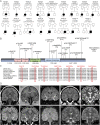Expanding the Mutational Landscape and Clinical Phenotype of CHD2-Related Encephalopathy
- PMID: 39035822
- PMCID: PMC11259532
- DOI: 10.1212/NXG.0000000000200168
Expanding the Mutational Landscape and Clinical Phenotype of CHD2-Related Encephalopathy
Abstract
Objectives: To present a case series of novel CHD2 variants in patients presenting with genetic epileptic and developmental encephalopathy.
Background: CHD2 gene encodes an ATP-dependent enzyme, chromodomain helicase DNA-binding protein 2, involved in chromatin remodeling. Pathogenic variants in CHD2 are linked to early-onset conditions such as developmental and epileptic encephalopathy, drug-resistant epilepsies, and neurodevelopmental disorders. Approximately 225 diagnosed patients from 28 countries exhibit various allelic variants in CHD2, including small intragenic deletions/insertions and missense, nonsense, and splice site variants.
Results: We present the molecular and clinical characteristics of 17 unreported individuals from 17 families with novel pathogenic or likely pathogenic variants in CHD2. All individuals presented with severe global developmental delay, childhood-onset myoclonic epilepsy, and additional neuropsychiatric features, such as behavioral including autism, ADHD, and hyperactivity. Additional findings include abnormal reflexes, hypotonia and hypertonia, motor impairment, gastrointestinal problems, and kyphoscoliosis. Neuroimaging features included hippocampal signal alterations (4/10), with additional volume loss in 2 cases, inferior vermis hypoplasia (7/10), mild cerebellar atrophy (4/10), and cerebral atrophy (1/10).
Discussion: Our study broadens the geographic scope of CHD2-related phenotypes, providing valuable insights into the prevalence and clinical characteristics of this genetic disorder in previously underrepresented populations.
Copyright © 2024 The Author(s). Published by Wolters Kluwer Health, Inc. on behalf of the American Academy of Neurology.
Conflict of interest statement
P. Striano received support from Italian MoH (Ricerca Corrente 2023) and Fondazione San Paolo. Research supported by PNRR-MUR-M4C2 PE0000006 Research Program MNESYS—A multiscale integrated approach to the study of the nervous system in health and disease. IRCCS G. Gaslini is a member of ERN-Epicare. Go to Neurology.org/NG for full disclosures.
Figures

References
Grants and funding
LinkOut - more resources
Full Text Sources
